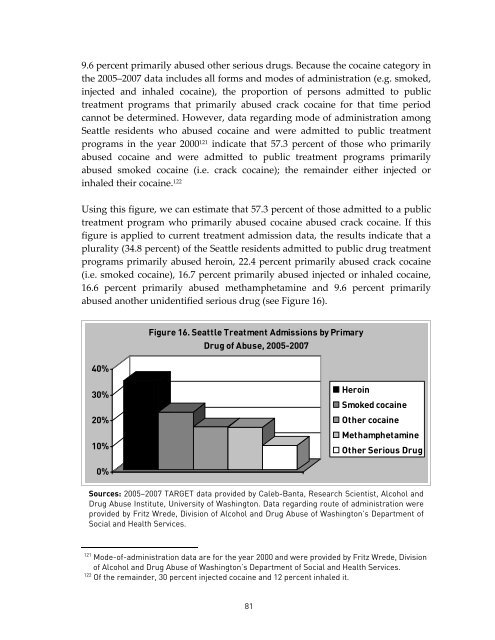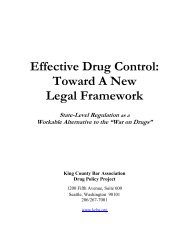RACE AND THE ENFORCEMENT OF DRUG DELIVERY LAWS IN ...
RACE AND THE ENFORCEMENT OF DRUG DELIVERY LAWS IN ...
RACE AND THE ENFORCEMENT OF DRUG DELIVERY LAWS IN ...
You also want an ePaper? Increase the reach of your titles
YUMPU automatically turns print PDFs into web optimized ePapers that Google loves.
9.6 percent primarily abused other serious drugs. Because the cocaine category in<br />
the 2005–2007 data includes all forms and modes of administration (e.g. smoked,<br />
injected and inhaled cocaine), the proportion of persons admitted to public<br />
treatment programs that primarily abused crack cocaine for that time period<br />
cannot be determined. However, data regarding mode of administration among<br />
Seattle residents who abused cocaine and were admitted to public treatment<br />
programs in the year 2000 121 indicate that 57.3 percent of those who primarily<br />
abused cocaine and were admitted to public treatment programs primarily<br />
abused smoked cocaine (i.e. crack cocaine); the remainder either injected or<br />
inhaled their cocaine. 122<br />
Using this figure, we can estimate that 57.3 percent of those admitted to a public<br />
treatment program who primarily abused cocaine abused crack cocaine. If this<br />
figure is applied to current treatment admission data, the results indicate that a<br />
plurality (34.8 percent) of the Seattle residents admitted to public drug treatment<br />
programs primarily abused heroin, 22.4 percent primarily abused crack cocaine<br />
(i.e. smoked cocaine), 16.7 percent primarily abused injected or inhaled cocaine,<br />
16.6 percent primarily abused methamphetamine and 9.6 percent primarily<br />
abused another unidentified serious drug (see Figure 16).<br />
40%<br />
Figure 16. Seattle Treatment Admissions by Primary<br />
Drug of Abuse, 2005-2007<br />
30%<br />
20%<br />
10%<br />
Heroin<br />
Smoked cocaine<br />
Other cocaine<br />
Methamphetamine<br />
Other Serious Drug<br />
0%<br />
Sources: 2005–2007 TARGET data provided by Caleb-Banta, Research Scientist, Alcohol and<br />
Drug Abuse Institute, University of Washington. Data regarding route of administration were<br />
provided by Fritz Wrede, Division of Alcohol and Drug Abuse of Washington’s Department of<br />
Social and Health Services.<br />
121<br />
Mode-of-administration data are for the year 2000 and were provided by Fritz Wrede, Division<br />
of Alcohol and Drug Abuse of Washington’s Department of Social and Health Services.<br />
122<br />
Of the remainder, 30 percent injected cocaine and 12 percent inhaled it.<br />
81

















